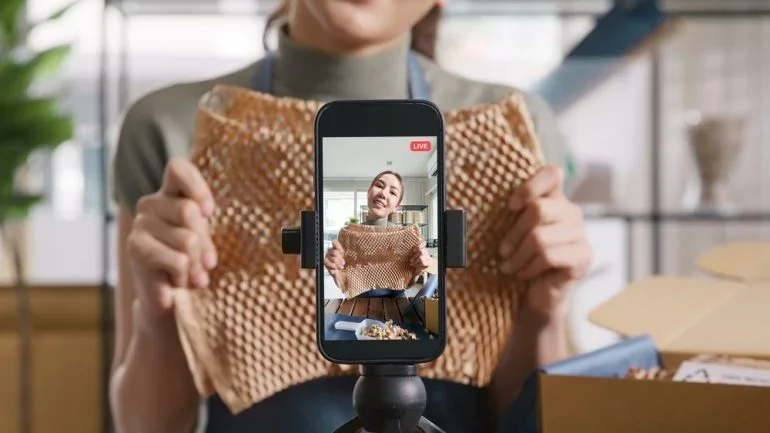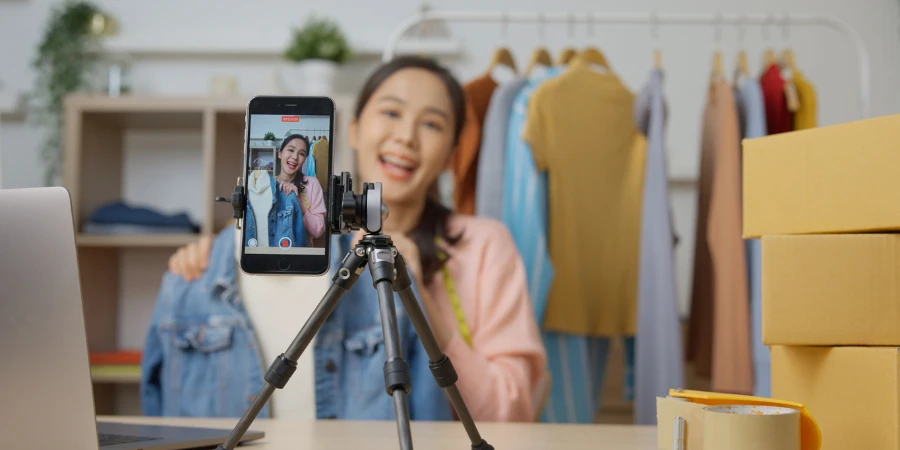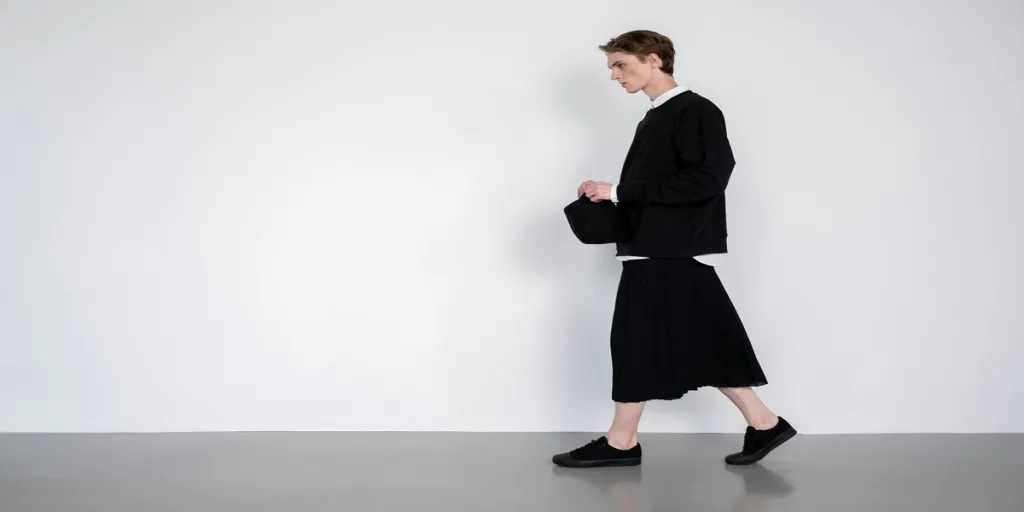Young consumers are increasingly using social media shopping platforms, such as TikTok Shop to buy their fashion goods, but what does this mean for the traditional fashion retail landscape and what are the pros and cons of tapping into this new retail channel?

The world of fashion retail experienced a seismic shift with the advent and rise of online shopping. Fast forward to today and social media platforms like TikTok are successfully bringing fashion consumers together as part of live shopping broadcasts with models and influencers trying clothes, footwear and accessories in real time.
With over 63 million posts tagged #fashion on TikTok alone, such platforms are not just influencing how consumers discover and purchase fashion items, but they are also reshaping the entire fashion retail landscape.
Rise of social media shopping for younger consumers
Research conducted by intelligence company Morning Consult found millennials are the “most consistent” social media shoppers, using shopping features on all platforms at higher rates than the rest of the population, particularly Facebook and YouTube.
In line with this trend, Gen Z adults were found to be using shopping features on other apps at similar rates as millennials, well ahead of older generations.
The report also revealed that even though Gen Z are the biggest demographic using TikTok, millennials are more likely to have used TikTok Shop relative to their platform usage with 37% of millennials claiming to have made a purchase on TikTok Shop.
A spokesperson from TikTok Shop told Just Style that its users lead the way in social commerce penetration, with 44% having made a purchase directly on TikTok, and one in four purchasing on the platform at least once a month.
This surge in social media fashion shopping is becoming a significant force, impacting everything from brand operations to consumer behaviour.
According to a report by accountancy firm KPMG, Gen Z is spearheading the future growth and trajectory of the retail industry. The report states that “social commerce” is the most popular channel for Gen Z shoppers especially in China, Vietnam, Indonesia and the Philippines.
Why are fashion shoppers choosing social media shopping?
GlobalData’s retail analyst Chloe Collins broke down what is driving fashion consumers to shop on social media platforms: “Consumers are increasingly relying on platforms like Instagram and TikTok to discover the latest fashion trends and brands, through influencers as well as brands’ own content.”
Collins highlighted the convenience such platforms offer, with in-app purchases aiding conversion once shoppers have seen an item they like.
This is exemplified through TikTok Shop’s ‘discovery e-commerce’ model which a spokesperson from the platform said is “redefining e-commerce.”
The spokesperson said: “This innovative approach offers a seamless, one-stop shopping experience that puts the joy back into shopping. Through a content-first approach and using features such as Tiktok Live, the platform provides businesses and brands with an effective way to promote products ensuring that every interaction is not just a transaction but an opportunity for growth, connection and engagement with their community.”
With platforms like TikTok Shop revolutionising the traditional retail model, GlobalData’s retail analyst Neil Saunders identified two main points of disruption: discovery and buying. Discovery is more established and about people finding fashion and brands and deciding what to buy.
He believes social media does a great job of doing this through direct advertising by brands and by influencers showcasing things they’ve bought or that they like.
What does this mean for the fashion industry?
Saunders views social media as both an opportunity and a complex channel requiring thoughtful integration into business strategies: “Social is another channel fashion retailers and brands need to be conscious of and have a strategy for. Most will at least want to use the platforms to showcase products and new launches, some will want to sell directly.”
He explained that, given the “reasonably strong” margins in fashion, many social media shops will turn a profit. However, as much as Saunders believes in the power of this new avenue, he is quick to point out that margins are often much lower than traditional retail because social marketing and advertising costs are not cheap. Plus, there is the expense of distribution and logistics, and dealing with returns.
Ideally, Saunders envisions social media shopping and traditional brick-and-mortar stores as complementary channels. But is that the case?
He elaborated on how the diversity of the audience and their purpose is a major driver of these two channels. Traditionally, social media has been more about advertising and showcasing products, while stores offer experience and smart fashion brands have used it for the same purpose – to create noise that drives shoppers into stores. Saunders marked this grey area, stressing the importance of effectively overlapping these channels to maximise their potential.
How can fashion brands leverage this new trend?
TikTok’s spokesperson highlighted the booming social commerce industry in the UK, predicting it will more than double in the next four years, rising from £7.4bn ($9.61bn) to almost £16bn by 2028.
“This means that social commerce would become 10% of the total online commerce market, up from 6% today, and growing at four times the rate of overall e-commerce sales,” the spokesperson noted.
TikTok emphasised the ultimate hack to engage with this community is through authentic and engaging content: “Having a content-first approach is the key to success for businesses of all sizes.”
Online fashion retailer ASOS has already embraced this strategy. ASOS told Just Style that it launched a collection of design products on the TikTok Shop in March to ensure it is “showing up in places that are native to its core customer group of fashion-loving 20-somethings.”
This move emphasises the importance of meeting consumers where they are most active and engaged.
Following trends with a hint of caution
Despite agreeing that social media offers a “much more level playing field” for brands, Saunders advises fashion brands to take a cautious approach.
He explains that while bigger brands can buy impressions, it is harder to buy genuine engagement. Small brands that are creative and authentic can garner a lot of attention, potentially going viral and transforming their sales and visibility overnight.
At the same time, he warned brands of the expenses that come with social media marketing, noting how it has become more costly over time.
He added: “It is also a very crowded space, and it can be hard to gain visibility. Social media is also fickle so what’s hot one minute, is out the next. It is also a channel that can backfire: poor campaigns and brands that are seen as out of touch can get criticism hurdled at them on social media.”
Collins, on the other hand, suggested brands use social media not just as a marketing tool but also as a selling channel. She expects social media to become even more dominant as Gen Z ages and gains greater spending power, and Gen Alpha begins to use it heavily too.
Cons of social media shopping for fashion brands and consumers
The rise of social media platforms for selling has significantly boosted the market for pre-loved goods, giving unwanted items a second life and reducing the overall carbon footprint of retail, according to the UK retail trade association British Retail Consortium (BRC). However, this trend comes with its own set of challenges and risks.
While the increased market for second-hand goods is a positive environmental step, the BRC noted that purchasing from social media platforms often comes with fewer quality guarantees, greater challenges in returning items, and an increased risk of scams compared to established retailers.
The BRC elaborated: “Lesser-known platforms may lack robust data security measures, increasing the risk of financial information theft whereas using reputable websites limits exposure to scams.”
In contrast to these concerns, the TikTok Shop spokesperson emphasised how the platform is focused on creating a shopping experience people love and trust.
“Whether an item is discovered through the For You Page or searched for on the Shop tab, TikTok facilitates safe and secure transactions for a quick, smooth checkout process all within the app,” the spokesperson explained. “Fake or unauthorised replicas of an authentic product are forbidden on TikTok Shop. We have strict IP and counterfeit policies in place which merchants must adhere to. There are thousands of trusted sellers fashion shoppers can explore and discover on TikTok Shop.”
These platforms may offer lucrative new ways for consumers to shop and fashion brands to sell, but they also bring challenges that need to be navigated to ensure a safe and satisfactory experience.
Source from Just Style
Disclaimer: The information set forth above is provided by just-style.com independently of Alibaba.com. Alibaba.com makes no representation and warranties as to the quality and reliability of the seller and products.




